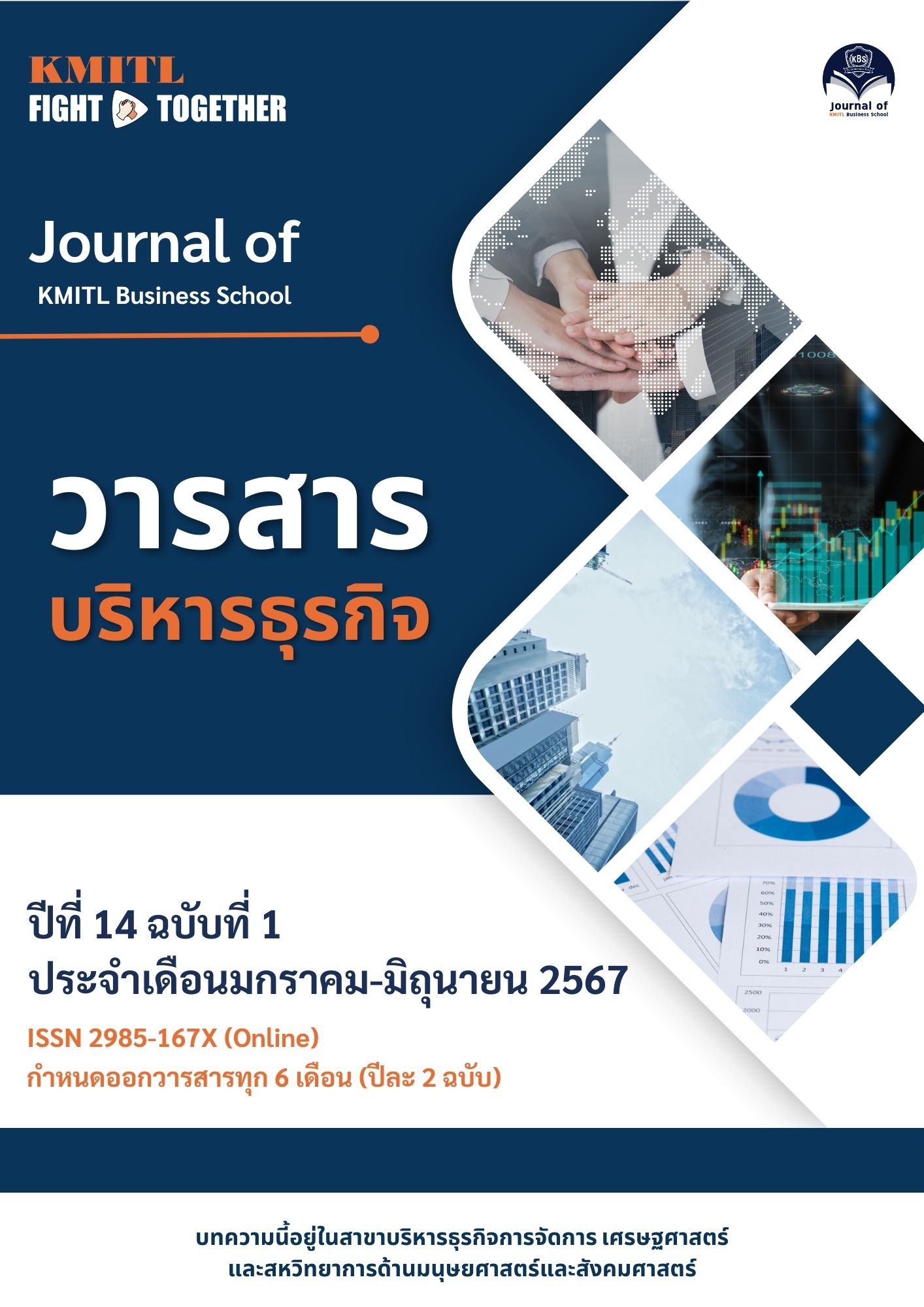Factors Influencing the Decision on Labor Mobility to Working Abroad: A Case Study of Students at King Mongkut’s Institute of Technology Ladkrabang
Main Article Content
Abstract
This study is quantitative research with the objectives to study demographic factors and environmental factors that influence the decision to move labor to work abroad of students at King Mongkut's Institute of Technology Ladkrabang. The independent variables include demographic factors include gender, faculty, occupation of the head of the family, average monthly income of the head of the family, and the number of siblings who are currently studying and environmental factors include push factors and pull factors, The dependent variable is the decision to move workers to work abroad. The sample group in this research was 371 fourth-year undergraduate students at King Mongkut's Institute of Technology Ladkrabang. The research instrument was an online questionnaire. For the data analysis, statistics used in descriptive data analysis were frequency, percentages, mean and standard deviations. The statistics used in inferential data analysis were the Two-Sample Independent t-test statistic, the Kruskal-Wallis Test statistic, and the Correlation Analysis statistic. The study’s results found that factors that significantly affect the decision to move workers to work abroad include demographic factors consisting of faculties, environmental factors consisting of push factors and pull factors. Therefore, the findings can be interpreted that relevant agencies should give importance to factors that influence the decision to move workers to work abroad by cooperating from all sectors. Focusing on creating stability in political, social, and economic to attract investment that leads to employment and increases the quality of life. A high quality of life will be the main factor that attracts people to not move to work abroad, as well as to maintain the number of laborers that work domestically.
Article Details

This work is licensed under a Creative Commons Attribution-NonCommercial-NoDerivatives 4.0 International License.
Journal of KMITL Business School is available both online and in printed version.
**All articles or opinions presented in this issue of the Journal of KMITL Business School reflect the thoughts of their respective authors. This journal serves as an independent platform for a variety of viewpoints. Authors bear full responsibility for the content of their articles.**
**All articles published in this journal are copyrighted by KMITL Business School, King Mongkut's Institute of Technology Ladkrabang. The editorial team permits copying or using articles, but a reference to the journal is required.**
References
กรมการจัดหางาน. (2564, 3 มิถุนายน). โอกาสของตลาดแรงงานหลังโควิด-19. https://www.doe.go.th/prd/assets/upload/files/satun_th/563c4c05905c678a263bce8bab7d2b7c.pdf.
กองบริหารแรงงานไทยไปต่างประเทศ กรมการจัดหางาน. (2566). ข้อมูลสถิติการเดินทางไปทำงานต่างประเทศ.
https://www.doe.go.th/prd/overseas/statistic/param/site/149/cat/81/sub/0/pull/module/view/list-label.
กัลยา วานิชย์บัญชา และ ฐิตา วานิชย์บัญชา. (2564). การใช้ SPSS for Windows ในการวิเคราะห์ข้อมูล (พิมพ์ครั้งที่ 33). สามลดา.
กิตติ ภักดีวัฒนะกุล. (2546). คัมภีร์สารสนเทศ (พิมพ์ครั้งที่ 3). เคทีพี คอมพ์ แอนด์ คอนซัลท์.
ณัฐฐฐิติ คำมูล. (2564, 13 พฤษภาคม). เกิดอะไรขึ้นกับประเทศไทย เมื่อคนรุ่นใหม่ “อยากย้ายประเทศ”https://www.sanook.com/news/8380706/.
ณัฐธยาน์ ยางทอง และคณะ. (2560). แนวโน้มการตัดสินใจเคลื่อนย้ายแรงงานในธุรกิจโรงแรมสู่อาเซียน: กรณีศึกษาจังหวัดสงขลา. TNI Journal of Business Administration and Languages, 5 (2), 35-39.
บุญคง หันจางสิทธิ์. (2558). เศรษฐศาสตร์ทรัพยากรมนุษย์ (พิมพ์ครั้งที่ 2). โอเอส พริ้นติ้ง เฮ้าส.
ปรมะ สตะเวทิน. (2546). หลักนิเทศศาสตร์ (พิมพ์ครั้งที่ 10). ภาควิชาการประชาสัมพันธ์ คณะนิเทศศาสตร์ จุฬาลงกรณ์มหาวิทยาลัย.
โพสต์ทูเดย์. (2562, 29 เมษายน). เข้าใจความต่างคน 4 เจเนอเรชั่น ทลายช่องว่างเพื่อการทำงานที่แฮปปี้. https://www.posttoday.com/lifestyle/587633.
รศนา อัชชะกิจ. (2537). กระบวนการแก้ไขปัญหาและตัดสินใจเชิงวิทยาศาสตร์ (พิมพ์ครั้งที่ 2). จุฬาลงกรณ์มหาวิทยาลัย.
ระบบสารสนเทศสำนักทะเบียนและประมวลผลสถาบันเทคโนโลยีพระจอมเกล้าเจ้าคุณทหารลาดกระบัง. (2565). รายงานจำนวนนักศึกษาปัจจุบันทั้งหมด. http://www.reg.kmitl.ac.th/student_statistics_static/statistic_present.php.
วิลาสินี สัญราชา. (2555). ปัจจัยที่มีผลต่อการตัดสินใจในการเคลื่อนย้ายแรงงานจากกรุงเทพมหานครเข้าสู่ประชาคมเศรษฐกิจอาเซียน. บริหารธุรกิจมหาบัณฑิต เอกธุรกิจระหว่างประเทศ, มหาวิทยาลัยเทคโนโลยีราชมงคลธัญบุรี.
วุฒิชัย จำนงค์. (2523). พฤติกรรมการตัดสินใจ (พิมพ์ครั้งที่ 1). โอเดียนสโตร์.
สุรพงษ์ คงสัตย์ และ ธีรชาติ ธรรมวงศ์. (2551). การหาค่าความเที่ยงตรงของแบบสอบถาม (IOC). https://www.mcu.ac.th/article/detail/14329.
Becker, G. (1975). Human Capital. Journal of Demographic Economics, 1 (81), 27-31.
Castles, S., & Miller, M. (1998). The Age of Migration: International Population Movements in the Modern World (2nd edition). Guilford Press.
Da Vanzo, J. (1978). Does unemployment affect migration? Evidence from microdata. Review of Economics and Statistics, 60 (4), 504-514.
Gallin, J. (2004). Net migration and state labor market dynamics. Journal of Labor Economics, 22 (1), 1-22.
Herzog, H., & Schlottmann, A. (1981). Labor force migration and allocative efficiency. Economic Inquiry, 19 (3), 459-475.
Lee, E. (1966). A Theory of Migration. Demography, 3 (1), 47-57.
Long, L. (1973). Migration differentials by education and occupation: Trends and variations. Demography, 10 (2), 243-258.
Mincer, J. & Jovanovic, B. (1981). Labor mobility and wages. In Sherwin Rosen, ed. Studies in labor markets. University of Chicago Press.
Quinn, M. & Rubb, S. (2005). The importance of education-occupation matching in migration decisions. Demography, 42 (1), 153-167.
Schultz, T. (1961). Investment in Human Capital. The American Economic Review, 1 (5), 1-17.
The International Organization for Migration. (2021, 1 December). World Migration Report 2022. https://publications.iom.int/books/world-migration-report-2022.


